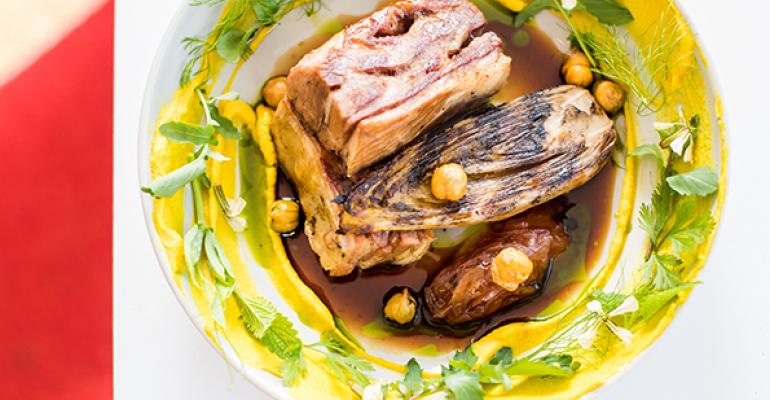Harissa, the zesty Tunisian sauce typically made with chiles, garlic, cumin, coriander, caraway and olive oil, is not just for couscous anymore. Chefs of all ethnic backgrounds at restaurants of all kinds are increasingly serving it with everything from seafood to cheese, and even in chicken wraps.
According to recent research from Datassential MenuTrends, a slew of Mediterranean ingredients have begun showing up on more menus in recent years. Harissa is among the fastest growing Mediterranean ingredients, appearing on 78 percent more menus than just four years ago.
[CHARTBEAT:3]
“I love harissa because it’s so versatile, you can use it as a condiment, marinade or even a sauce,” said Ricardo Jarquin, chef of Travelle Kitchen + Bar in Chicago. “It’s like the North African version of Sriracha — you can put it on anything and it will take it to the next level.”

Jarquin is currently using harissa to kick octopus up a notch. For his crispy octopus with pork belly, salsa verde and snap peas, he marinates the seafood in a harissa paste made with chile peppers, garlic, vinegar, spices and sugar before crisping it up in a cast iron pot. He also folds harissa into an aïoli made with preserved lemons and piquillo peppers that accompanies the octopus.
Though it has only been on the menu a month, the crispy octopus is a best seller, and one Jarquin says he plans to leave on the menu for a while.

Also preparing octopus with harissa is Gaby Hakman, executive chef and owner of The Majestic in Alexandria, Va. Hakman is currently serving charred octopus with harissa vinaigrette, chickpeas and oil-cured olives. For that dish she takes the flavor profile of harissa in dry spice form and mixes it in with freshly squeezed lemon, garlic and olive oil, then whisks it all together to make the vinaigrette. She lightly tosses watercress and micro cilantro in the vinaigrette, and then drizzles it over the charred octopus.
 “[I like] the complexity of the flavors, the balance of heat and spice,” Hakman said. “[Harissa] is so versatile and adds so much to virtually any dish.”
“[I like] the complexity of the flavors, the balance of heat and spice,” Hakman said. “[Harissa] is so versatile and adds so much to virtually any dish.”
On the menu since the restaurant opened in late May, the octopus is one of The Majestic’s most popular dishes.
At Blueacre Seafood in Seattle, chef de cuisine Richard Graham frequently uses harissa on the menu because he says he “likes the creaminess and complexity of spice it can add to a dish.” He uses the condiment most often in the spring and summer with crusted fish. Currently on the menu is an olive-crusted Alaska halibut with the Greek garlic paste skordalia, harissa sauce and cucumber tarator (a Middle Eastern sauce with ground walnuts, garlic, and yogurt or tahini).
“We’re seeing a lot of Middle Eastern cuisine cross over to classic style preparations here in Seattle,” Graham said. “This is a great example of it.”
Harissa doesn’t just get along well with seafood; chefs also like how nicely it plays with meat and vegetables dishes.
For example, at Sable Kitchen & Bar in Chicago chef Lawrence Letrero is serving cumin-glazed lamb pops with harissa and spiced peanuts for dipping. And at The Signature Room, also in Chicago, chef Cardel Reid offers a chicken wrap with harissa aïoli and a vegetable phyllo with harissa sauce.
Meanwhile, at Ray’s and Stark Bar inside the Los Angeles County Museum of Art, executive chef Fernando Darin offers up harissa spice-rubbed lamb belly with chickpea purée and roasted endive, garnished with crispy chickpeas and fresh herbs from the restaurant’s garden.
“I like cooking with harissa because it gives dishes heat but also provides a unique, earthy flavor that not many people are accustomed to,” Darin said. “I am always trying to find new flavors that will surprise guests at Ray’s and provide them with a new sensory experience.”





